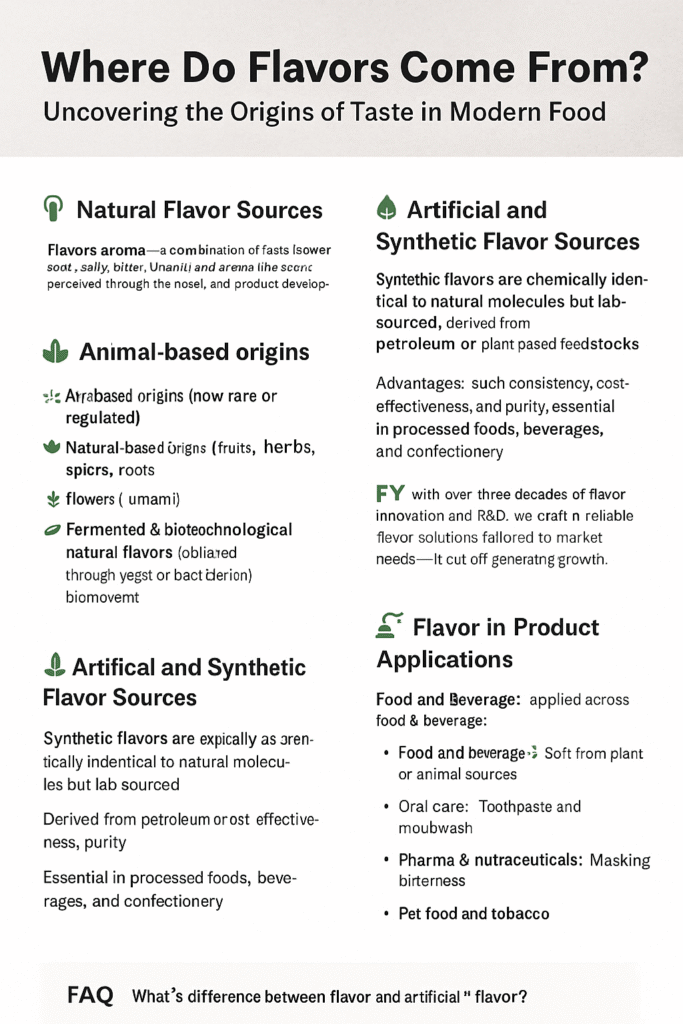Where Do Flavors Come From? Unveiling the Secrets of Modern Taste Creation
Introduction: What Is Flavor?
Flavor is more than just taste—it’s a multisensory experience combining aroma, taste, and mouthfeel. The sweetness of a candy or the cool freshness of toothpaste comes from meticulously crafted flavor systems. In industries such as food, beverage, oral care, and pharmaceuticals, flavor plays a critical role.
As a global leader in the flavor and fragrance industry, FY Flavors & Fragrances combines nature and science to create safe, sustainable, and culturally resonant flavor solutions for markets across Africa, Southeast Asia, the Middle East, and South America.

Natural Flavor Sources
🌿 Plant-Based Ingredients
Natural flavors often come from various plant parts, including:
- الفواكه: Citrus peels, berries, mango
- Herbs: Mint, basil, thyme
- Spices: Clove, cinnamon, cardamom
- Flowers: Jasmine, rose, orange blossom
- Roots: Ginger, turmeric, licorice
These components are typically extracted through distillation, expression, or solvent extraction. FY prioritizes ethical sourcing and works closely with global farming cooperatives.
🐾 Animal-Derived Ingredients (Rare Today)
Previously used in perfumes and some flavorings, ingredients such as castoreum or civet have been replaced by synthetic or biotech-based versions for ethical and regulatory reasons.
🧫 Biotechnological Innovations
Through fermentation and enzyme engineering, FY develops natural-identical flavor molecules using yeast or bacteria. Examples include:
- Fermentation-derived vanillin
- Gamma-decalactone (peach flavor)
- Methylbutyrate (apple note)
Artificial and Synthetic Flavor Sources
🔬 What Are They?
Synthetic flavors are compounds created in the lab that mimic natural molecules. They are:
- Chemically identical to their natural counterparts
- Derived from petroleum or plant-based raw materials
- Stable and reproducible across batches
💼 Why Use Them?
- Weather-independent production
- High heat stability (important in baking, extrusion, etc.)
- Cost-effective for large-scale applications
FY uses green chemistry techniques to reduce environmental impact and ensure high purity and safety in all synthetic flavor offerings.
How Flavors Are Made at FY
🧪 Natural Extraction Methods
FY uses tailored technologies depending on the source:
- Steam Distillation: Ideal for mint, eucalyptus, lavender
- Cold Pressing: Used for extracting citrus oils
- Solvent Extraction: Common for delicate florals like jasmine
- Supercritical CO₂ Extraction: Clean, solvent-free, and ideal for high-end applications
🧬 Artificial Synthesis & AI
FY’s R&D team leverages:
- Proprietary molecule libraries
- AI algorithms for trend prediction and flavor matching
- Molecular modeling to anticipate aroma interactions in complex food systems
👃 The Role of Flavorists
Our expert team of flavorists works at the intersection of science, artistry, and consumer insight to create:
- Balanced sensory profiles (top, heart, base notes)
- Multilayered flavor expressions
- Customized solutions for specific formats: RTD beverages, gummies, syrups, toothpastes, etc.
Industry Applications
FY flavors are found in:
- 🍧 المأكولات والمشروبات: Fruit juices, dairy, confectionery, snacks, sauces, baked goods
- 🦷 Oral Care: Toothpaste, mouthwash, breath sprays, dental floss
- 💊 Supplements: Vitamin gummies, effervescent tablets, protein powders
- 🐶 Pet Nutrition: Enhanced palatability for kibbles and wet food
- 🚬 Tobacco Alternatives: Herbal shisha, nicotine-free sticks, oral pouches
Safety and Compliance
FY meets or exceeds international regulatory and safety standards:
- FEMA GRAS (U.S. flavor safety body)
- IFRA (Fragrance industry regulations)
- REACH (EU chemical safety regulation)
- Halal / Kosher / Vegan Certified products
- In-house labs equipped with GC-MS, HPLC, FTIR
- Dedicated sensory evaluation panels
All products come with documentation: Safety Data Sheets (SDS), TDS, Certificate of Analysis (COA), and allergen declarations.
Trends & Innovation at FY
- ✅ Clean Label: Simplified ingredient lists, recognizable sources
- 🌱 Plant-Based/Vegan Expansion: Supporting plant-based meats, milks, desserts
- 🤖 AI-Based Customization: Predictive design for taste preferences by region or demographic
- 🌏 Localized Flavor Systems: For African spiced teas, Southeast Asian mango-coconut blends, Middle Eastern cardamom-saffron pairings
FY also collaborates with universities and innovation labs to stay ahead of market shifts and regulatory evolution.
الخاتمة
Behind every delicious bite or refreshing sip is a complex journey of sourcing, extraction, innovation, and sensory design. FY bridges nature and technology to ensure that brands deliver exceptional taste experiences—consistently and responsibly.
From clean-label juice blends to vegan oral care flavors, FY is shaping the next generation of global flavor innovation.
FAQ
Q1: Are FY’s flavors safe?
Yes. All flavors are thoroughly tested and comply with FEMA GRAS, IFRA, REACH, and applicable national regulations.
Q2: Do you offer custom flavors?
Absolutely. FY specializes in co-creating flavor systems with brands to meet cultural preferences, application formats, and consumer trends.
Q3: Are vegan and halal flavors available?
Yes. FY has an extensive range of certified Halal, Kosher, and Vegan flavor solutions.
Q4: Where are FY’s natural flavors sourced from?
From global partners including citrus farms, herb plantations, and sustainable spice networks—with full traceability.
Q5: What are your best flavors for oral care?
Popular examples include Tea Mint, Herbal Lemon, Fresh Cooling Spearmint, and Sweet Herbal Citrus—all optimized for fluoride and surfactant systems.
